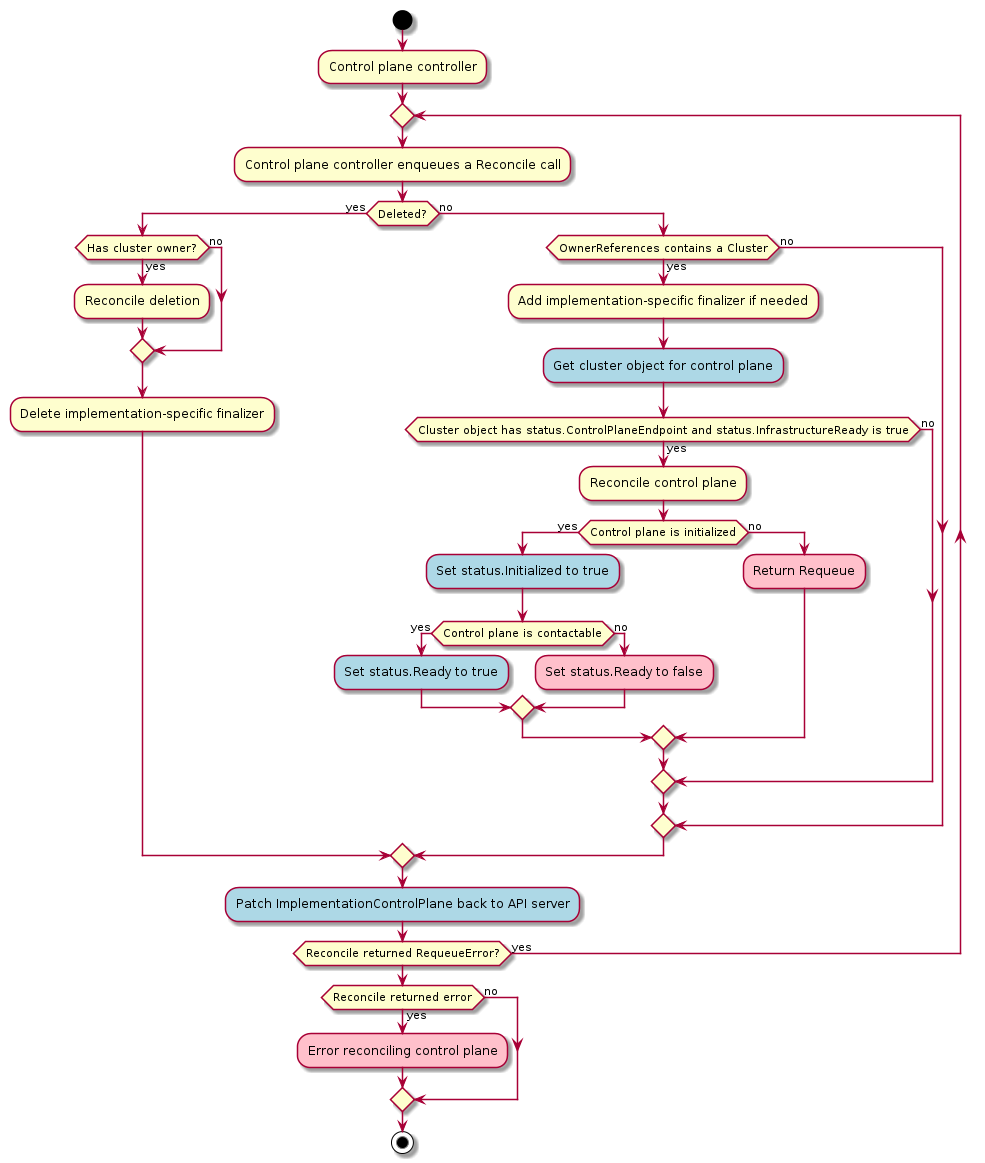Control Plane Controller

The Control Plane controller’s main responsibilities are:
- Managing a set of machines that represent a Kubernetes control plane.
- Provide information about the state of the control plane to downstream consumers.
- Create/manage a secret with the kubeconfig file for accessing the workload cluster.
A reference implementation is managed within the core Cluster API project as the
Kubeadm control plane controller (KubeadmControlPlane). In this document,
we refer to an example ImplementationControlPlane where not otherwise specified.
Contracts
Control Plane Provider
The general expectation of a control plane controller is to instantiate a Kubernetes control plane consisting of the following services:
Required Control Plane Services
- etcd
- Kubernetes API Server
- Kubernetes Controller Manager
- Kubernetes Scheduler
Optional Control Plane Services
- Cloud controller manager
- Cluster DNS (e.g. CoreDNS)
- Service proxy (e.g. kube-proxy)
Prohibited Services
- CNI - should be left to user to apply once control plane is instantiated.
Relationship to other Cluster API types
The ImplementationControlPlane must rely on the existence of
status.controlplaneEndpoint in its parent Cluster object.
CRD contracts
Required spec fields for implementations using replicas
-
replicas- is an integer representing the number of desired replicas. In the KubeadmControlPlane, this represents the desired number of desired control plane machines. -
scalesubresource with the following signature:
scale:
labelSelectorPath: .status.selector
specReplicasPath: .spec.replicas
statusReplicasPath: .status.replicas
status: {}
More information about the scale subresource can be found in the Kubernetes documentation.
Required status fields
The ImplementationControlPlane object must have a status object.
The status object must have the following fields defined:
| Field | Type | Description | Implementation in Kubeadm Control Plane Controller |
|---|---|---|---|
initialized
| Boolean | a boolean field that is true when the target cluster has completed initialization such that at least once, the target's control plane has been contactable. | Transitions to initialized when the controller detects that kubeadm has uploaded a kubeadm-config configmap, which occurs at the end of kubeadm provisioning. |
ready |
Boolean | Ready denotes that the target API Server is ready to receive requests. | |
Required status fields for implementations using replicas
Where the ImplementationControlPlane has a concept of replicas, e.g. most
high availability control planes, then the status object must have the
following fields defined:
| Field | Type | Description | Implementation in Kubeadm Control Plane Controller | |
|---|---|---|---|---|
readyReplicas |
Integer | Total number of fully running and ready control plane instances. | Is equal to the number of fully running and ready control plane machines | |
replicas |
Integer | Total number of non-terminated control plane instances, i.e. the state machine for this instance of the control plane is able to transition to ready. | Is equal to the number of non-terminated control plane machines | |
selector |
String | `selector` is the label selector in string format to avoid introspection by clients, and is used to provide the CRD-based integration for the scale subresource and additional integrations for things like kubectl describe. The string will be in the same format as the query-param syntax. More info about label selectors: http://kubernetes.io/docs/user-guide/labels#label-selectors | ||
unavailableReplicas |
Integer | Total number of unavailable control plane instances targeted by this control plane, equal to the desired number of control plane instances - ready instances. | Total number of unavailable machines targeted by this control plane. This is the total number of machines that are still required for the deployment to have 100% available capacity. They may either be machines that are running but not yet ready or machines that still have not been created. | |
updatedReplicas
|
integer | Total number of non-terminated machines targeted by this control plane that have the desired template spec. | Total number of non-terminated machines targeted by this control plane that have the desired template spec. |
Optional status fields
The status object may define several fields:
failureReason- is a string that explains why an error has occurred, if possible.failureMessage- is a string that holds the message contained by the error.externalManagedControlPlane- is a bool that should be set to true if the Node objects do not exist in the cluster. For example, managed control plane providers for AKS, EKS, GKE, etc, should set this totrue. Leaving the field undefined is equivalent to setting the value tofalse.
Example usage
kind: KubeadmControlPlane
apiVersion: cluster.x-k8s.io/v1alpha3
metadata:
name: kcp-1
namespace: default
spec:
infrastructureTemplate:
name: kcp-infra-template
namespace: default
kubeadmConfigSpec:
clusterConfiguration:
version: v1.16.2
Kubeconfig management
Control Plane providers are expected to create and maintain a Kubeconfig secret for operators to gain initial access to the cluster. If a provider uses client certificates for authentication in these Kubeconfigs, the client certificate should be kept with a reasonably short expiration period and periodically regenerated to keep a valid set of credentials available. As an example, the Kubeadm Control Plane provider uses a year of validity and refreshes the certificate after 6 months.